Turquoise. This gem that I love. I mean LOVE. It's in almost every Lumenrose piece. Looking at and choosing the stones I work with is pretty much my favorite part of my job. I want to share a little bit about differentiating between qualities of stones and what to look for in high quality stones. I am not a gemologist, nor do I know exactly how turquoise prices are set, but here are some things I have learned from stone-cutters, sellers and miners over the decade+ I have been working with turquoise.
.

.
First off I have to say that quality of turquoise is a somewhat subjective thing. Regardless of the price per carat, the shine, the color, the matrix etc, if you love the look of a particular stone, that makes it special to you no matter what anyone else. values it at.
.
Alright, let's dive in.
.
The stones below are some of the most inexpensive stones I purchased this year. I think they are beautiful. They are lovely colors and shapes with soft hues of greens and blues. Their lack of distinct matrix or patterning, though, is part of why they are not high priced gems. Also, these come from a mix of Chinese and Mexican mines that have an abundance of the material, so there is no premium placed on them for scarcity.
.

.
Rarity is a large factor in why a particular kind of turquoise may tend to be highly valued. If there was relatively little material mined from a particular mine, the price of that material can be exponentially higher than average. For example, turquoise from Bisbee, AZ is very highly priced from most sellers because there is a finite quantity of that material in circulation since the mine has been closed for decades. A single stone can be well over $1000.
.
In terms of looking at a stone and being able to guess as to its inherent quality or value, I tend to look for the vibrancy and depth of color, the crispness of the matrix if it is present (the matrix is the veining you can see) and the shine of the stone, which indicates how hard it is. Harder equals shinier, which equals higher "gem" quality- think of more sparkly gems such as quartz, sapphire etc, which are shiny and much harder.
.
These Royston stones below are "high grade", meaning they are higher quality. Can you tell why?
.

.
Here's what I see: they have very rich color, the two on either end have crisp matrix patterning and there is a delightful sheen to all three which shows they are on the harder spectrum of turquiose. Also, I paid twice as much per carat for these as I usually pay.
.
Turquoise cabochons are generally priced per carat. That price can range from around $1/carat and up. Lately it's hard to find nice turquoise for less than $3/carat. $4 or $5/carat and up usually means the stone is of higher quality. It might not sound like much, but it adds up. A mid size stone may be around 10 carats, so at $3/carat it costs $30. This gets marked up at least 3 times in the process of pricing in order to maintain healthy business margins. (It isn't just $30 that gets spent here. There's shipping costs and time spent corresponding with the stone seller online or the expense and time of actually traveling to shop for stones in person.)
.
Much of the turquoise that is mined is quite chalky and soft. This kind of turquoise undergoes a stabilization process that hardens it and enhances the color so it can withstand cutting and shaping with lapidary equipment. In my experience, a lot of stabilized turquoise has a flat look to it. I tend to use mainly natural turquoise in my work. That said, there are some mines that produce turquoise that is gorgeous once it is stabilized. Some of the Patagonia, Arizona turquoise I work with is stabilized. The array of color, shine, and matrix of these stones is incredible:
.

.
As I said, this turquoise valuing is quite a subjective business. I personally love more green and teal turquoise over blue so that's part of my own preferences for what I deem to be a beautiful stone. What color of turquoise are you most drawn to?
.

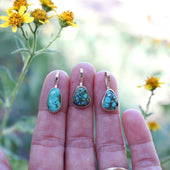
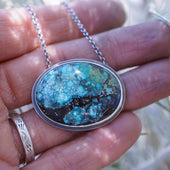
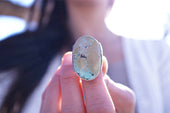

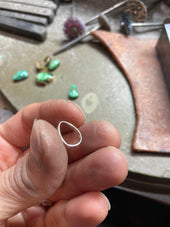
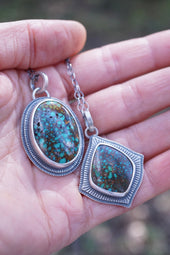
2 comments
Your passion and knowledge of turquoise gems shines! I learned so much from this post!
Thank you for this article it was very interesting